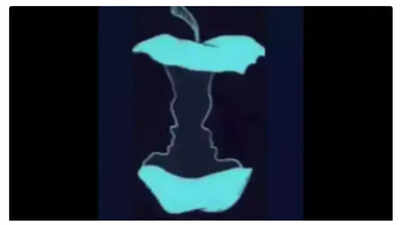Optical illusions have surged in popularity, offering a stimulating mental workout and a unique way to test your observational skills. More than just entertainment, these illusions reveal fascinating insights into how our brains process information. An optical illusion arises when the brain misinterprets visual input, leading to perceptions that differ from reality. This can involve seeing movement in static images or perceiving unequal sizes in identical shapes.

The image above, initially shared by Marina Winberg, presents a classic optical illusion: do you see an eaten apple or two faces? Your initial perception may unveil a core aspect of your personality. Take a moment to carefully examine the image before reading on.
Winberg explains, "This image is a classic dual-illusion where you can either see two faces (a man and a woman) looking at each other OR an apple core—what you notice first says a lot about your mindset!"
If you see the two faces first: According to Winberg, "You’re a logical, analytical thinker with strong morals. You think before you act, value stability, and solve problems creatively— but sometimes, curiosity gets the best of you!”
If you saw the apple first: Winberg suggests, "You’re intuitive, emotionally aware, and great at reading subtle cues. You know the right thing to say, but often stay quiet. Stability matters to you, and you protect what’s important.”
Optical illusions are categorized into three primary types:
Literal Illusions: These illusions occur when the brain combines different components of an image and creates something that isn't actually there. An example is perceiving two faces or a vase in the same picture, depending on your interpretation.
Physiological Illusions: These illusions arise from overstimulation of the visual system due to excessive exposure to light, color, or movement. This can lead to afterimages or the perception of motion where there is none.
Cognitive Illusions: These illusions are based on the brain's subconscious interpretation of information. A classic example is the Müller-Lyer illusion, where lines appear to be of different lengths due to the surrounding shapes.
Newer articles
Older articles
 Rishabh Pant: Greg Chappell Hails India Star as Cricket Revolutionary
Rishabh Pant: Greg Chappell Hails India Star as Cricket Revolutionary
 Bumrah Boosts India's Hopes: Star Pacer Returns to Bowling Drills Ahead of Edgbaston Test
Bumrah Boosts India's Hopes: Star Pacer Returns to Bowling Drills Ahead of Edgbaston Test
 Shadman Islam Backs Bangladesh Batters Despite Day 1 Setbacks Against Sri Lanka
Shadman Islam Backs Bangladesh Batters Despite Day 1 Setbacks Against Sri Lanka
 Black Caps Set for Blockbuster Home Summer Against Cricket Giants
Black Caps Set for Blockbuster Home Summer Against Cricket Giants
 Harshit Rana Released from India's Test Squad Ahead of Second England Clash
Harshit Rana Released from India's Test Squad Ahead of Second England Clash
 Hydration Habits Could Significantly Cut Hypertension, Heart Failure Risk, Study Finds
Hydration Habits Could Significantly Cut Hypertension, Heart Failure Risk, Study Finds
 Prasidh Krishna Vows to Sharpen Bowling Accuracy After Expensive Spell
Prasidh Krishna Vows to Sharpen Bowling Accuracy After Expensive Spell
 Mirabai Chanu Reveals Relentless Training Demands, Weight Concerns Impact Family Time
Mirabai Chanu Reveals Relentless Training Demands, Weight Concerns Impact Family Time
 India's Fielding Blunders Under Scrutiny After First Test Loss to England
or
Ex-Selector Blasts India's Costly Dropped Catches in England Test Defeat
India's Fielding Blunders Under Scrutiny After First Test Loss to England
or
Ex-Selector Blasts India's Costly Dropped Catches in England Test Defeat
 Gavaskar Calls for Kuldeep Yadav's Inclusion in Second Test Amid Bumrah Fitness Concerns
Gavaskar Calls for Kuldeep Yadav's Inclusion in Second Test Amid Bumrah Fitness Concerns